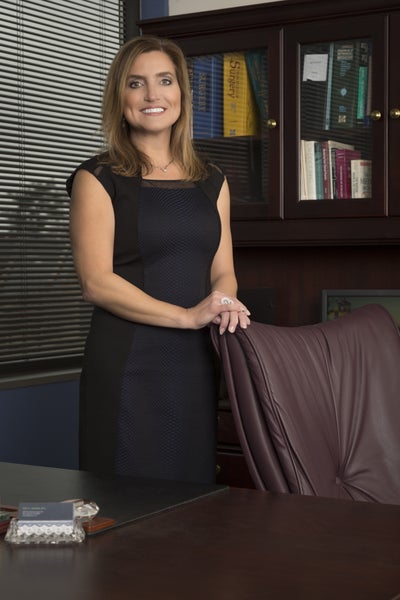Renuvion (formerly J-Plasma or J Plasty) is a minimally invasive skin rejuvenation and firming treatment that is FDA-cleared for:
- treating moderate to severe wrinkles and rhytides (aka lines) in patients with Fitzpatrick skin types I–III (via the Renuvion Dermal Handpiece), a treatment its manufacturer refers to as “facial renewal”
- addressing skin laxity on the neck and under the chin (the submental area), using the Renuvion APR Handpiece
- tightening loose skin on the body, following liposuction, with the Renuvion APR Handpiece (a new indication announced by the FDA in April 2023)
Even prior to its most recent FDA clearance, the device was commonly used “off label” to shrink and smooth skin on several areas of the body, including the abdomen, bra line, back, thighs, breasts, arms, knees, and legs.
Renuvion works by delivering a precise stream of cold plasma energy—created by energizing helium gas with radiofrequency (RF) waves—to the surface of the skin, as a resurfacing treatment, or underneath it (“subdermally”), using a long, thin tube called a cannula.
Subdermally, the combination of high-energy heat and the plasma’s cold temperature causes collagen to contract and skin to tighten.
Via inconspicuous, tiny incisions, the device delivers energy to the underside of the skin, instantly firming from the inside out, with the built-in safety of tissue cooling (courtesy of the helium gas).
Results continue to improve as the body heals and new collagen forms.
“Renuvion includes helium, which cools the skin, so there is less thermal injury to the superficial skin” and a lower risk of burns than body contouring treatments that rely on heat alone, says Dr. Umbareen Mahmood, a plastic surgeon in New York City. However, this assumes that the procedure is being performed by a board-certified plastic surgeon or dermatologic surgeon who has vast experience with the device.
The skin tightening treatment is commonly paired with liposuction, for optimal body contouring results.
Beverly Hills, California, plastic surgeon Dr. Charles Galanis finds that radiofrequency energy technologies like Renuvion “are bridging the gap between people who need something like an arm lift and people who don’t but still have loose skin—in other words, giving them something short of surgery to tighten skin.” In fact, some plastic surgeons market Renuvion for the arms as a "scarless arm lift."
He still finds, however, that Renuvion works best as a complement to other procedures. “If someone is coming in because their arms are a trouble spot, it’s rare that [the problem] is just skin. For most people, particularly those in their 30s to 50s, it’s a combination of excess fat and [lax] skin.” He’ll remove the fat first via liposuction and then insert the Renuvion cannula into a lipo incision, to tighten skin and improve the result.
Someone with more severe skin laxity, particularly after extreme weight loss or multiple pregnancies, usually isn't a good candidate for this procedure alone. In that situation, plastic surgeons generally recommend a surgical procedure, like a tummy tuck, to remove significant excess skin.
Pros
- As a standalone treatment, Renuvion can subtly tighten loose skin on the body.
- Used in conjunction with liposuction, Renuvion can improve results by tightening the skin envelope, thwarting sagging after the fat has been removed, and making muscles look more pronounced.
- This cosmetic procedure can be performed on the lower face and neck (to tighten jowls and define the jawline), as well as on the body.
- Unlike some skin-tightening treatments, which require multiple treatment sessions over several weeks, Renuvion is a single treatment.
- Renuvion creates both immediate skin contraction and a long-term boost in new collagen production over several months.
- Compared to a surgical procedure, such as an arm lift, this skin tightening procedure comes with minimal downtime and scarring.
Cons
- While Renuvion is a minimally invasive procedure, it requires either general anesthesia or local anesthesia with sedation, depending on the extent of your treatment.
- If you have significant loose skin, this procedure won’t give the same dramatic tightening results as plastic surgery to remove excess skin.
- It takes time for new collagen to develop, so you may not see the full benefits of Renuvion for six to nine months.
- Social downtime can range from a few days to several weeks, depending on the extent of your procedure.
- Side effects include discomfort and swelling, which may be visible for up to three months afterward.
- Rarer but more serious risks include burns, scars, skin color changes, nerve damage, infection, bleeding, hematoma, or seroma, a build-up of fluid under the skin. Seek out an experienced, board-certified plastic surgeon and follow their aftercare instructions carefully.
- Average Cost:
- $5,941
- Range:
- $2,249 - $17,385
The price you pay will depend on your provider’s level of experience, their practice location, and the extent of your treatment.
If your doctor is treating a large area and you require general anesthesia, your procedure will be far more costly than treating a smaller area prepped with a local anesthetic.
You can finance your treatment with CareCredit.
The Renuvion photos in our gallery have been shared by the provider who performed the procedure, with the patient's consent.
Good candidates for Renuvion have mild sagging of the cheeks, jowls, neck, or other treatment areas. Ideal patients are nonsmokers who are in good health and within five to 10 pounds of their ideal weight.
It's important to have realistic expectations for what this treatment can achieve. For some, a Renuvion procedure can be a good way to delay surgery. “I find Renuvion particularly useful for patients that dislike the appearance of their neck due to loose skin, excess fat, or both, but are not quite ready for a neck or facelift—or can't have one due to underlying medical conditions," says Dr. Ellen Janetzke, a plastic surgeon in Bloomfield Hills, Michigan.
For those with more advanced signs of aging in their faces, a surgical facelift or neck lift may be a better option. Likewise, for those with excessively sagging skin on the body paired with stretch marks, a body contouring surgery, such as a tummy tuck, is usually a better option in terms of the result it can deliver.
A subdermal Renuvion procedure takes about an hour. Here’s what to expect on the day of your procedure.
- Depending on the size of the treatment area, you’ll receive either general anesthesia (you’ll be completely asleep) or a local anesthetic, possibly with oral or IV sedation to keep you relaxed and comfortable.
- Your doctor will make a small incision and insert the long, thin cannula under the skin.
- They’ll move the cannula back and forth as RF energy ionizes the helium gas, turning it into a stream of cool plasma that contracts existing collagen fibers and stimulates new collagen production.
- When your treatment is complete, you’ll recover from the anesthesia and be monitored in order to ensure you’re stable.
- You’ll be sore and groggy afterward, so it’s best to arrange for a ride home from someone you trust.
Recovery time after subdermal Renuvion skin tightening varies with the scope of the procedure, but you can expect to need 2 to 3 days off work for a standalone procedure and 7 to 10 days off work if you’ve also had liposuction.
Healing from subdermal Renuvion happens from the inside out. You can expect mild swelling and bruising, and your doctor may recommend wearing a compression garment on the treated area for four to six weeks, to promote healing and reduce swelling.
Your doctor will provide specific aftercare instructions. You may experience some discomfort as your body heals, so wait about two weeks for the swelling and soreness to resolve before engaging in exercise or other strenuous activity.
“You’ll see a difference in your skin’s elasticity right after the procedure and continue to see improvements in your skin over several months,” as new collagen forms, according to Dr. Gregory Turowski, a plastic surgeon in Skokie, Illinois.
You’ll be anesthetized (possibly even asleep) during Renuvion treatment, so you won’t need to worry about feeling the heat or jabs of the cannula.
During recovery, you’ll be deeply sore for a couple of weeks, but the discomfort should be manageable with over-the-counter pain medication.
Renuvion is considered safe for good candidates, in the hands of an experienced provider. However, you should be aware of safety concerns that were raised soon after the device first launched.
In March of 2022, the FDA issued a warning against the use of Renuvion for certain aesthetic procedures, after receiving reports of serious adverse events that occurred when the device was used on or under skin. Complications included burns, infection, skin color changes, scars, nerve damage, bleeding, and air or gas accumulation under the skin. The FDA specifically cautioned against its use for dermal resurfacing or “skin contraction.”
However, in late May 2022, the FDA cleared the Renuvion Dermal Handpiece to treat moderate to severe wrinkles and rhytides on patients with Fitzpatrick skin types I-III, significantly softening their stance on "dermal resurfacing" for patients with light skin.
In April 2023, the agency also cleared the APR Handpiece “for coagulation of subcutaneous soft tissues following liposuction for aesthetic body contouring,” sanctioning its use as a skin-tightening tool.
While initial safety concerns have abated, it’s still important to seek treatment from a board-certified plastic surgeon or dermatologist who has extensive experience with this and other skin rejuvenation procedures that involve controlled heat.
Renuvion results can last for years, thanks to the stimulation of new collagen. Doctors on RealSelf are reluctant to give an exact duration for results or describe it as permanent, primarily because the forces of sun, time, gravity, and weight fluctuations will affect your skin after treatment exactly as they did before, weakening connective tissue and invariably causing stretching and sagging. Everyone ages differently, too.
The best things you can do to maintain your results are to eat a healthy diet, exercise regularly, avoid extreme weight fluctuations, and adopt a medical-grade skincare regimen (including regular sun protection).


